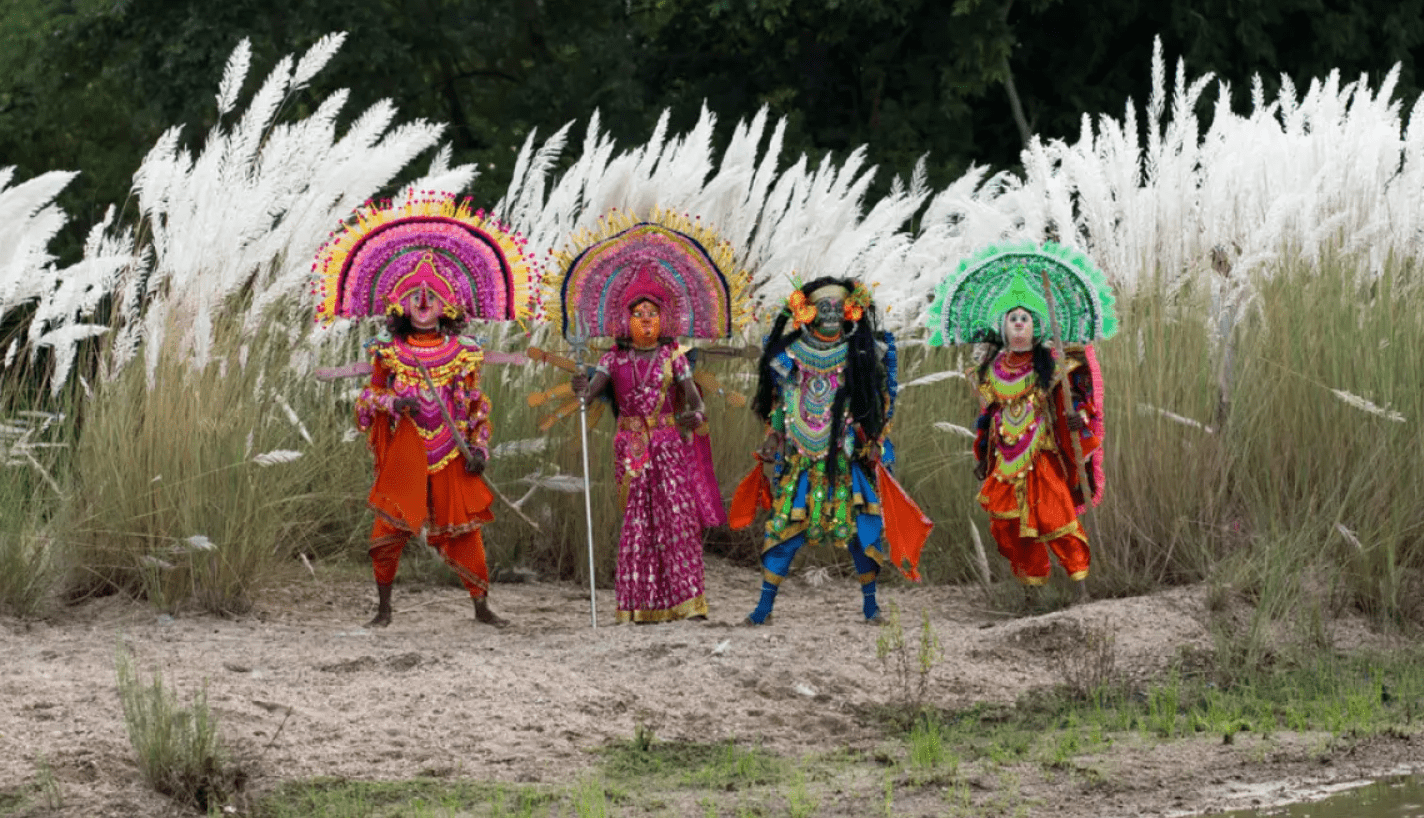Purulia Chhau Dance: This post is dedicated to the remarkable individuals who are tirelessly working to revive the rich art, craft, and heritage of Bengal and India. During our visit to Purulia for the Chhau-Jhumur Utsav in Bamnia, we were mesmerized by the breathtaking Purulia Chhau Dance performance. Additionally, our trip took us to Charida village, where we gained valuable insights into the creation of Purulia Chhau masks.
The grandeur of the masks worn by the dancers left me spellbound. I was curious about how such large masks could be maneuvered during the dance. I recalled my own experience participating in a folk dance competition wearing a farmer’s hat, which ended up falling off during the performance—an amusingly embarrassing moment from my childhood. Nonetheless, witnessing the Chhau dance masks in action was truly awe-inspiring.
Reflecting on my childhood, I recall participating in various singing and dancing competitions, a common aspiration for Bengali parents who encourage their children to excel in arts and culture. It was at a competition organized by my father’s office where I first encountered Chhau dance. The dancers’ agile movements and dramatic, acrobatic leaps captivated me. Although my memories of the event have faded—considering I was in second grade at the time—the image of the Chhau dancers and my own less-than-stellar performance remain vivid. That was my introduction to Purulia Chhau dance.
As a frequent traveler, I always wished to experience a Chhau dance performance at its origin in Purulia. Agni and I often explore offbeat destinations to witness cultural events, and our desire to delve deeper into the history of Chhau dance in Purulia was fulfilled during our visit in December 2018. We attended a Chhau performance in Baghmundi and returned in January for the Tusu Parob festival, another rural celebration.
Chhau dance is predominantly found in the tribal regions of eastern India, including West Bengal, Jharkhand, and Odisha. It features three primary styles: Purulia Chhau from West Bengal, Seraikela Chhau from Jharkhand, and Mayurbhanj Chhau from Odisha. Both Purulia and Seraikela Chhau incorporate masks, while Mayurbhanj Chhau does not.
The origins of Chhau dance are somewhat obscure but likely stem from indigenous martial arts and combative training. The dance movements mimic mock combat, animal gaits, and simple village life.
The term “Chhau” is thought to be derived from the Sanskrit word “Chhaya,” meaning shadow, due to the dancers’ silhouettes during performances. Alternatively, some suggest it comes from “Chhadma” (disguise) or “Chhauni” (military camp) due to the dance’s warrior-like nature.
Purulia Chhau Dance: A Masked Tradition
Purulia Chhau dance draws from martial arts and features performances on mythological themes from texts like the Ramayana, Mahabharata, and local legends. The dance is performed in open spaces to the rhythm of traditional drums like dhol and dhumsa, complemented by melodies from mohuri and shehnai.
Historically, the dance was supported by royal families and British governors. The Raja of Baghmundi was a key patron, influencing the elaborate design of Chhau masks.
Chhau Mask Making in Charida
Charida village, located in Baghmundi block of Purulia, is renowned for its Chhau masks. Over 500 families in Charida are involved in mask making. The process involves crafting molds from mud, layering them with paper and glue, and then decorating them with colors, beads, and other embellishments. Each mask represents a specific mythological character, with distinct features and colors.
Costumes and Performances
Costumes play a vital role in Chhau performances, varying based on the character portrayed. Male dancers wear colorful dhotis and kurtas, while female characters don vibrant sarees. Demons and deities have unique costumes, often featuring dramatic colors and designs.
Recognition and Preservation
Despite facing challenges from modernization, Chhau dance and mask making are experiencing a revival thanks to dedicated efforts. In 2010, Chhau dance was inscribed in UNESCO’s Representative List of the Intangible Cultural Heritage of Humanity, and Chhau masks have received Geographical Indication (GI) status.
Our Chhau-Jhumur Utsav Experience
We attended the Chhau-Jhumur festival in Bamnia, where performances included various mythological and folk stories, with the slaying of Ravan by Ram being a highlight. The performance, featuring elaborate costumes and acrobatic moves, was electrifying.
Travel Tips
The Chhau-Jhumur Utsav in Purulia was held from December 22-28, 2018, and will take place at Balarampur between December 20-22, 2019. Chhau dances also occur during the Gajan festival in mid-April.
How to Reach Bamnia, Purulia
You can travel to Purulia by train from Howrah, with a journey of about 5-6 hours. From Purulia, Bamnia is approximately 40 km away. Alternatively, you can take an overnight train to Muri Junction and then proceed to Jhalida, which is close to Bamnia.
Where to Stay
There are limited accommodation options in Bamnia, so staying in Purulia is advisable. We stayed at Amantran Lodge in Jhalda, a basic lodging facility.
